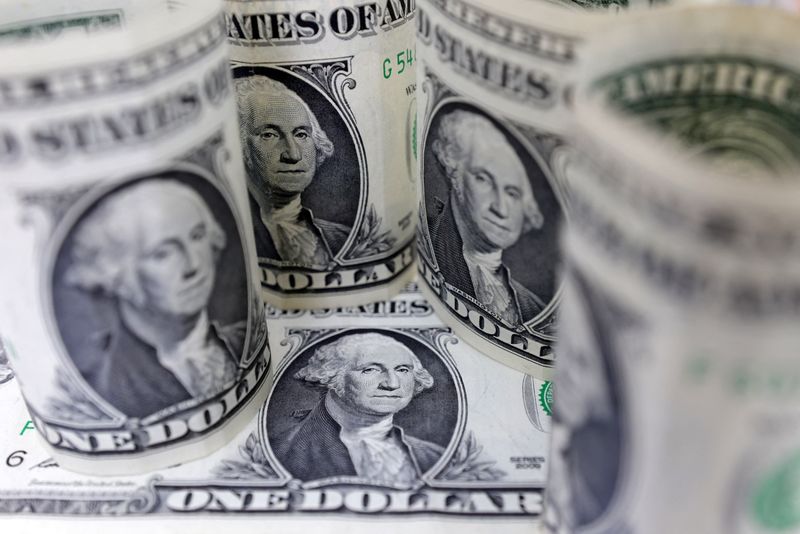
By Kevin Buckland
TOKYO (Reuters) – The greenback softened on Tuesday as merchants squared positions on the day of the U.S. presidential election, after latest polls dented some market bets on a victory for Republican Donald Trump.
Democrat Kamala Harris has additionally skilled bettering odds on election playing websites and had a slight lead on PredictIt in a single day, though Polymarket continued to point out Trump as favorite.
In latest weeks, monetary markets and a few betting platforms had leaned strongly in favour of a win for Trump, whose tariff and immigration insurance policies are thought of inflationary by analysts, resulting in an increase in U.S. Treasury yields and positive factors for the greenback.
In a single day, although, the U.S. foreign money slumped as a lot as 0.76% towards the euro to a three-week trough after a weekend opinion ballot confirmed Harris with a shock lead in Iowa, a standard Republican stronghold. General, polls proceed to point out a decent race.
The , which measures the foreign money towards six main friends together with the euro, edged down barely to 103.89 as of 0618 GMT, after slumping as little as 103.67 on Monday for the primary time since Oct. 21. Final week it surged to the very best for the reason that finish of July at 104.63.
The euro edged as much as $1.0879, after lifting to $1.09145 within the earlier session for the primary time since Oct. 15.
Sterling was barely larger at $1.2959.
Towards the yen, the greenback traded at 152.34, after slipping to 151.54 in a single day, a one-week low.
“We choose monetary markets are actually positioned for a Harris win,” mentioned Carol Kong, a foreign money strategist at Commonwealth Financial institution of Australia (OTC:).
“The USD can due to this fact fall modestly by 1%‑2% this week if Vice President Harris wins and raise materially if (former) President Trump wins,” she mentioned. “Any delays and/or disputes over vote counting also can add to foreign money volatility this week.”
The winner might not be identified for days after Tuesday’s vote, although Trump has already signalled that he’ll try to battle any defeat, as he did in 2020.
In a single day implied volatility choices for euro/greenback
added 2.2% to about $68,542, after dipping to a one-week low of $66,776.19 in a single day. Trump is seen by analysts as enacting extra beneficial insurance policies for cryptocurrencies than Harris.
“Whereas your guess is nearly as good as ours about who will win, we’re assured in regards to the eventualities (we) laid out lately: Briefly, a Trump win or Pink wave are bullish for the USD; a Blue Wave will crater the USD,” analysts at TD Securities mentioned in a be aware. “Someplace within the center lies a Harris victory.”
“We do not suppose Harris is essentially dangerous for the USD over the medium time period,” they mentioned. “Harris merely shifts the main target again to macro, whereas Trump reshapes the market narrative round politics.”
On Thursday, the Federal Reserve is predicted to chop charges by 25 foundation factors. Markets will deal with any clues that the U.S. central financial institution might skip a minimize in December, after final week’s month-to-month jobs report confirmed employers added far fewer jobs than economists had anticipated in October, elevating questions over the diploma of softness within the labour market.
Additionally on Thursday, the Financial institution of England is predicted to chop charges by 25 foundation factors, whereas the Riksbank is seen easing by 50 foundation factors, and the Norges Financial institution is about to remain on maintain.
The Reserve Financial institution of Australia held coverage regular on Tuesday, as extensively anticipated, and retained wording in its assertion that “coverage will should be sufficiently restrictive till the Board is assured that inflation is shifting sustainably in direction of the goal vary.”
RBA Governor Michele Bullock leaned barely hawkish in her information convention, saying she nonetheless believed there are upside dangers for inflation.
Merchants haven’t absolutely priced in a quarter-point fee minimize till the Might assembly.
The Australian greenback added 0.21% to $0.6600, discovering its toes after slumping to the weakest stage since Aug. 8 final week at $0.6537.
“Our central case is that the RBA’s first minimize is not going to arrive till Q2 2025, however we see an growing danger that it takes even longer for cuts to be delivered, or that the RBA misses the easing part altogether,” HSBC’s chief economist for Australia and New Zealand, Paul Bloxham, wrote in a be aware.

“This might come about as a result of home inflation continues to fall solely very slowly or as a result of, by the point home inflation has eased sufficiently, the worldwide economic system is already re-inflating,” he mentioned.
“We ascribe a 25% likelihood to the likelihood that the RBA doesn’t minimize its money fee in any respect in 2025.”